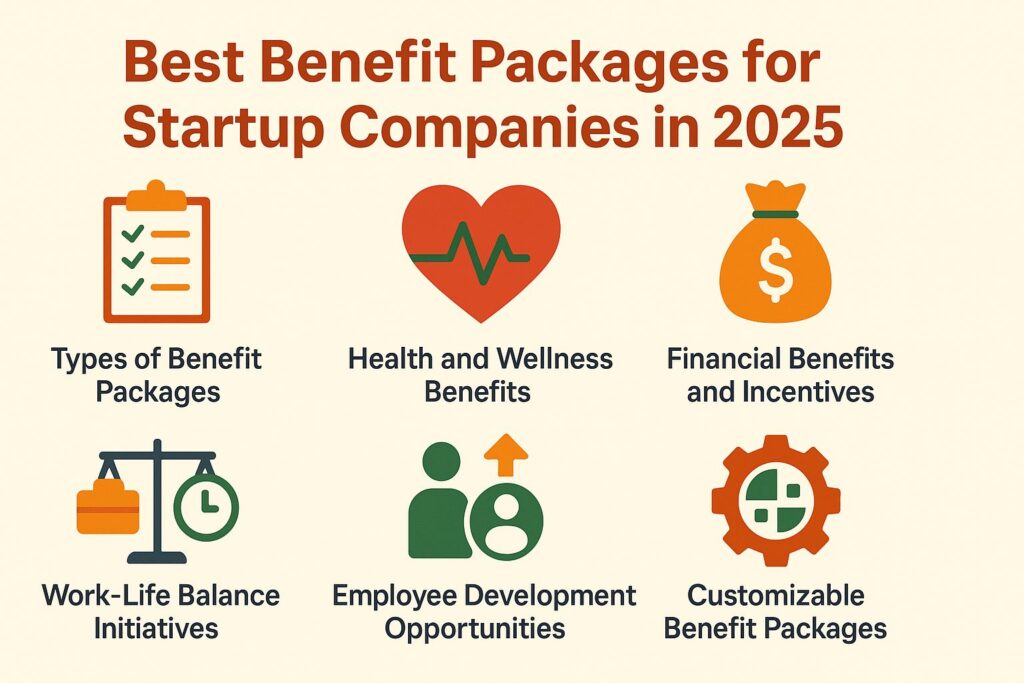
Best Benefit Packages for Startup Companies in 2025
Attracting top talent isn’t just about a great idea-you need the right benefits to stand out. In 2025, competitive benefit packages will be essential for startups aiming to thrive. You’ll learn about the newest employee benefits, including health insurance choices and flexible work schedules. Find out how health programs and financial rewards can increase employee motivation. Learn how to create benefit packages that help your team stay interested and driven.
Importance of Competitive Benefits and Compensation Packages
Good benefits packages increase employee happiness and job satisfaction, which are important for attracting new talent.
Startup companies that provide strong benefits can see job applications rise by up to 40%. Buffer, a startup where employees work from home, set up a complete health plan. This led to more employees staying and participating actively.
Providing options like flexible work schedules and professional development budgets helps attract top talent. Tools like Gusto and Zenefits can help manage benefits, ensuring they are attractive and orderly. This contributes to making your company an excellent workplace.
Trends in Employee Benefits for 2025
Recent changes in employee benefits show that workers now expect more options for well-being and flexible arrangements.
More companies are focusing on mental health support. There is a 22% increase in businesses providing therapy benefits and programs to help employees. For instance, Google provides employees with access to mental health days and virtual therapy sessions.
Similarly, remote work policies are gaining traction; 70% of firms have adopted flexible work setups, allowing employees to work from home or choose their hours.
Customizable benefits are on the rise, enabling workers to tailor their benefits, as seen in companies like Buffer that let employees select what matters most to them.
These trends highlight the growing emphasis on employee well-being and autonomy.
Types of Benefit Packages
A complete benefits package includes different parts designed to meet the different needs of employees and their families. To further enhance employee satisfaction and retention, understanding why employee retention matters more than ever can be vital (explored in our detailed analysis of the significance of retention strategies in 2025).

Health Insurance Options
Providing health insurance is often seen as a fundamental component of any employee benefits package, critical for employee well-being and talent retention.
Employers typically choose from Health Maintenance Organization (HMO), Preferred Provider Organization (PPO), or Exclusive Provider Organization (EPO) plans, considering legal compliance and tax implications.HMO plans offer lower premiums, averaging $300/month, but require members to use network providers and get referrals for specialists.
In contrast, PPO plans, averaging $500-$600/month, provide more flexibility in choosing healthcare providers and do not require referrals.
Startup companies like GitLab offer many perks, providing a full package that improves employee happiness and attracts talented workers.
Retirement Plans
Providing retirement plans like 401(k)s helps employees with their financial security and significantly improves talent retention rates.
Companies that add to employee contributions can increase loyalty. For example, a 4% match can improve retention by up to 25%.
Companies like Buffer have successfully used their 401(k) matching policy to bring in new employees, making them attractive to job seekers.
To implement a competitive retirement plan, analyze your budget, consider affordable plan providers, and communicate benefits communication strategies clearly to staff.
Start with training sessions to make sure employees know the long-term benefits of joining these plans.
Paid Time Off Policies
Generous Paid Time Off (PTO) policies can significantly improve the balance between work and personal life, making them an attractive benefit for employees.
Companies that adopt innovative PTO models often report higher employee satisfaction and retention. For example, Netflix’s policy of allowing unlimited vacation time has increased job satisfaction by 25%.
Traditional paid time off models, often allowing just two to three weeks, can restrict flexibility and make it harder to take time off.According to research, organizations offering unlimited PTO see a 39% reduction in employee burnout.
Looking at your company culture and what employees like can help you choose the best PTO plan to improve employee productivity and job satisfaction.
Flexible Work Arrangements
Flexible working hours are now a key factor for startups wanting to increase employee satisfaction and productivity.
For example, remote work allows employees to complete tasks from home, eliminating long commutes and enhancing work-life balance. Companies like Zapier have experienced a 40% increase in productivity by using these models.
Collaboration tools like Zoom and Slack are important for keeping team members connected and working together, allowing instant updates and talks.Startups can also implement flexible hours, allowing employees to choose their work times, which often leads to higher job satisfaction and a more engaged workforce.
Health and Wellness Benefits
Spending money on health and wellness helps workers stay physically and mentally healthy and creates a good workplace atmosphere. Additionally, crafting attractive compensation packages can further enhance employee satisfaction and retention. For an extensive analysis, our elaboration on compensation strategies offers valuable insights.

Comprehensive Health Plans
Complete health plans give employees broad coverage, which is important for their comfort and health.
These plans often include essential components such as dental, vision, and mental health coverage.
For example, a family plan might average around $500 per month, covering routine check-ups, glasses, and therapy sessions.
Companies like Salesforce have successfully implemented such plans, resulting in improved employee satisfaction and reduced turnover.
They focus on mental health by providing workshops, counseling, and employee help programs as part of their benefits package.This method improves employees’ health and builds a positive workplace culture.
Mental Health Support
Mental health help is now seen as an important part of employee benefits, showing the importance of encouraging supportive work environments.
Research indicates that 20% of workers face mental health issues. This points to the need for companies to offer useful support through employee help programs.
Programs like Employee Assistance Programs (EAPs) provide confidential counseling and advice, improving the work atmosphere and increasing employee involvement.
Companies like Microsoft are notable for providing a full range of mental health services and promoting work-life balance.They offer free access to therapists and mindfulness resources.
Incorporating regular check-ins and mental health days can further promote well-being, ensuring employees feel valued and supported in their roles.
Wellness Programs
Wellness programs aimed at promoting healthy lifestyles can lead to improved employee morale and productivity.
Companies that implement programs such as fitness challenges, nutrition counseling, and mental health resources often see significant benefits. For instance, organizations with wellness initiatives report a 30% reduction in healthcare costs over time.
Startups like Asana have successfully introduced complete wellness plans, offering free gym memberships and on-site health workshops, which help create a more involved workforce.
When companies focus on health and wellness initiatives, they improve morale and build a healthier, more productive work environment.
Financial Benefits and Incentives
Providing financial benefits can increase employee loyalty and help attract talented workers, aligning with their long-term financial goals.
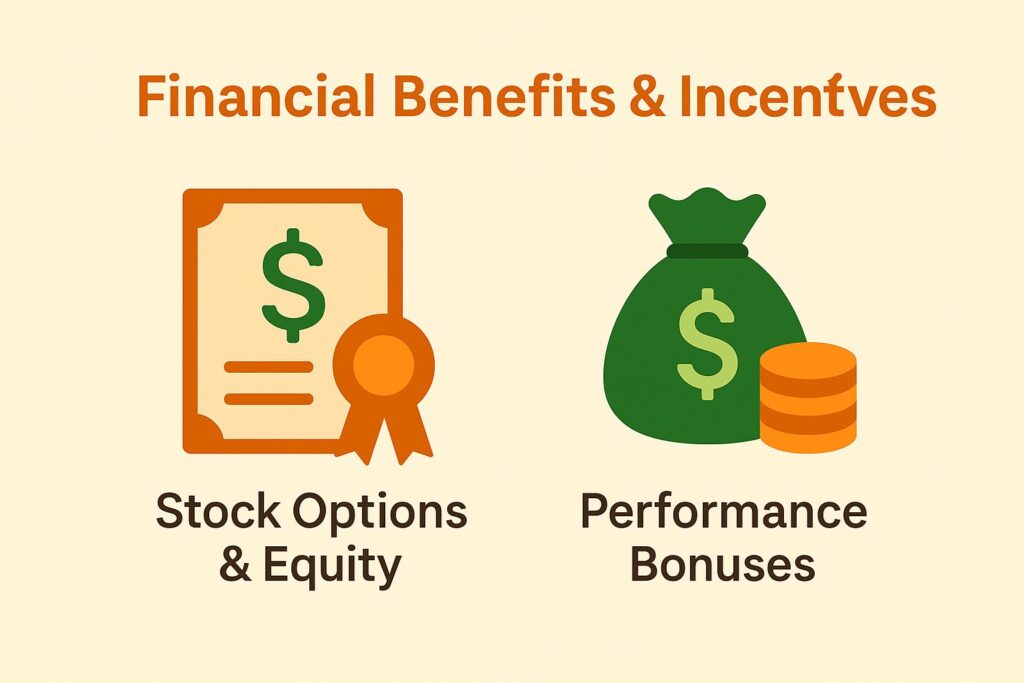
Stock Options and Equity
Offering stock options and equity compensation can be a powerful incentive for employees, aligning their interests with company success.
Typically, stock options come with a vesting schedule of four years, meaning employees earn the right to purchase shares gradually, often receiving 25% after the first year and the remainder monthly thereafter.
Companies like Airbnb offer stock options to attract talented employees, making their salary packages and hiring plans more attractive.Research indicates that startups providing equity options experience 35% higher retention rates, underscoring the effectiveness of this strategy.
When companies connect employees’ financial wellness achievements with the company’s progress, they create a more motivated and dedicated team.
Performance Bonuses
Performance bonuses encourage employees to do their best, promoting a strong work ethic in startups.
For instance, Lyft offers performance bonuses that range from 10% to 20% of an employee’s base salary, directly linked to the company’s growth metrics and business growth.This structure encourages employees to align their efforts with organizational goals.
Companies maximizing this strategy often notice heightened productivity and engagement. Explaining goals during performance reviews helps employees see how their work affects the company’s success.
By tying rewards such as performance bonuses to both personal and company success, startups create a motivated team focused on common goals.
Work-Life Balance Initiatives and Strategies
Creating work-life balance programs is important for keeping employees happy and ensuring employee loyalty, especially in busy startup settings.
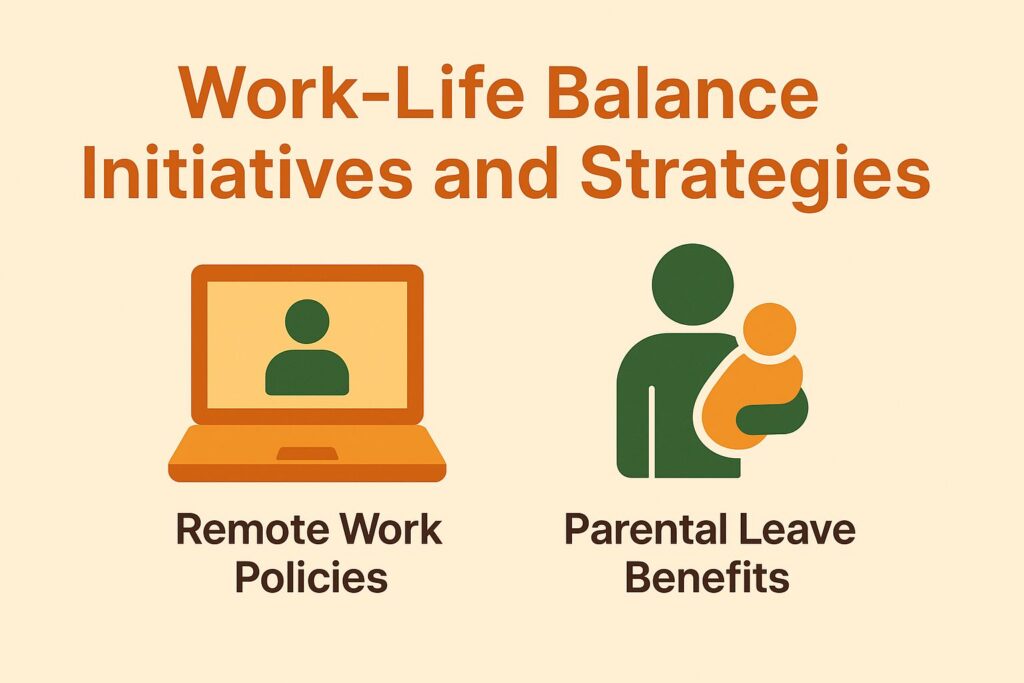
Remote Work Policies
Having clear rules for remote work benefits can improve how well employees perform and make them happier at work, especially those who do well with flexible schedules.
A complete remote work policy should cover rules on communication, performance standards, and working hours.
For example, you can use Trello to monitor project progress and assign tasks, while Zoom facilitates real-time teamwork and meetings, encouraging team interaction and cooperation.
Setting core hours allows employees to maintain a work-life balance while ensuring availability for team interactions. Regular meetings can build responsibility and solve problems quickly.
Research shows that 83% of employees prefer flexible working arrangements. This highlights how important these policies are for attracting and keeping employees.
Parental Leave Benefits
Parental leave benefits are important for helping employees during key life events, increasing job satisfaction and loyalty, and supporting diverse family needs.
Employers can offer maternity, paternity, and adoption leave, each modified to support various family arrangements and improve parental benefits.
Maternity leave typically allows for extended recovery time, with many companies providing 16-20 weeks, showcasing the importance of family leave. Paternity leave has also gained importance, with averages increasing to 10 weeks, helping new fathers engage more fully.
Adoption leave, though sometimes less frequent, is important for families bringing in children through adoption and usually lasts as long as maternity leave.
Startups like Spotify have found that their improved leave policies lead to a 30% lower employee turnover rate, highlighting the link between supportive parental leave and keeping employees, while promoting an inclusive startup culture.
Employee Development Opportunities
Providing training and learning chances for staff encourages progress and new ideas in startups, which directly affects their results and supports innovation. For startups exploring efficient ways to bolster their HR capabilities, understanding what HR services can be outsourced can be a strategic next step to streamline operations and enhance employee development.
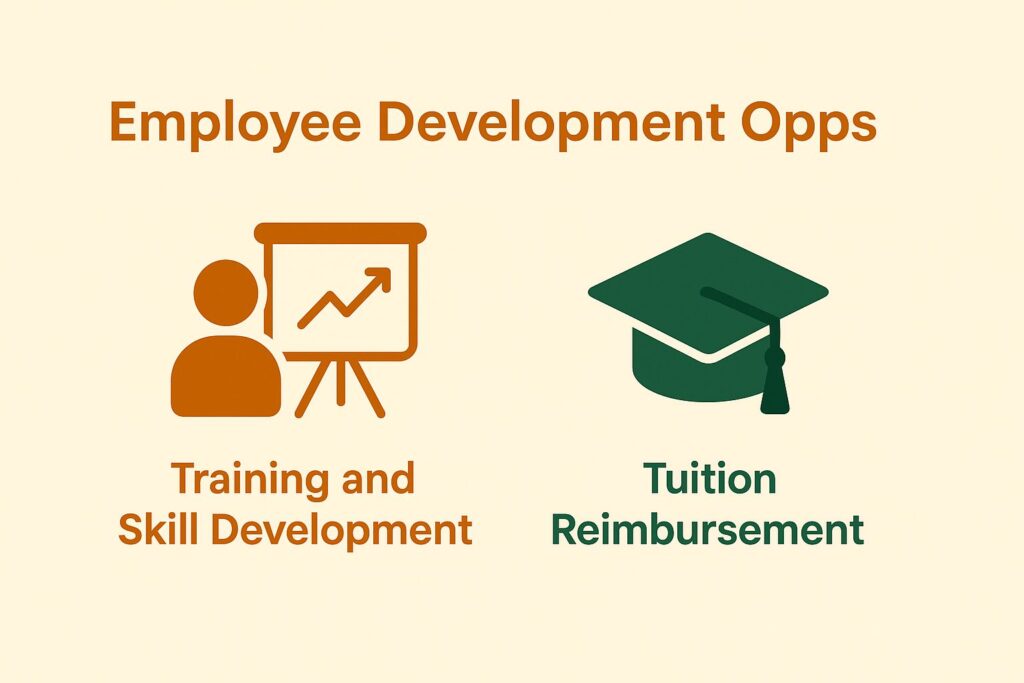
Training and Skill Development
Offering training and skill development programs equips employees with essential skills for personal and professional growth.
Investing in structured training initiatives can directly impact a company’s bottom line. For example, organizations that allocate resources to employee education often experience a 24% increase in profit margins.
Websites like Coursera and LinkedIn Learning offer many courses designed for different skill levels. Companies may choose workshops that focus on teamwork and communication, encouraging a cooperative setting.
Training sessions regularly increase how well employees work and raise their spirits, helping team members feel appreciated and involved in their careers, bridging the skills gap.
Tuition Reimbursement Programs and Skills Training
Tuition reimbursement programs can greatly improve employee loyalty and help bring in top candidates who want ongoing education options and support skills development.
Typically, companies offer reimbursement rates up to $5,250 per year, covering costs for courses, certifications, and degree programs. For instance, Deloitte’s program supports employees in their educational pursuits while reporting a 20% improvement in retention rates.
Investing in employee development helps organizations improve skills and encourages a culture of growth. To implement such a program, start by defining eligibility criteria, selecting covered courses, and setting a reimbursement process.
Using Bright Horizons makes handling management tasks easier and ensures clarity and transparency, supporting strategic HR and organizational growth.
Customizable Benefit Packages
Benefit packages that can be customized let employees choose options that fit their personal needs. This increases their happiness and involvement, and helps the workforce become more adaptable.
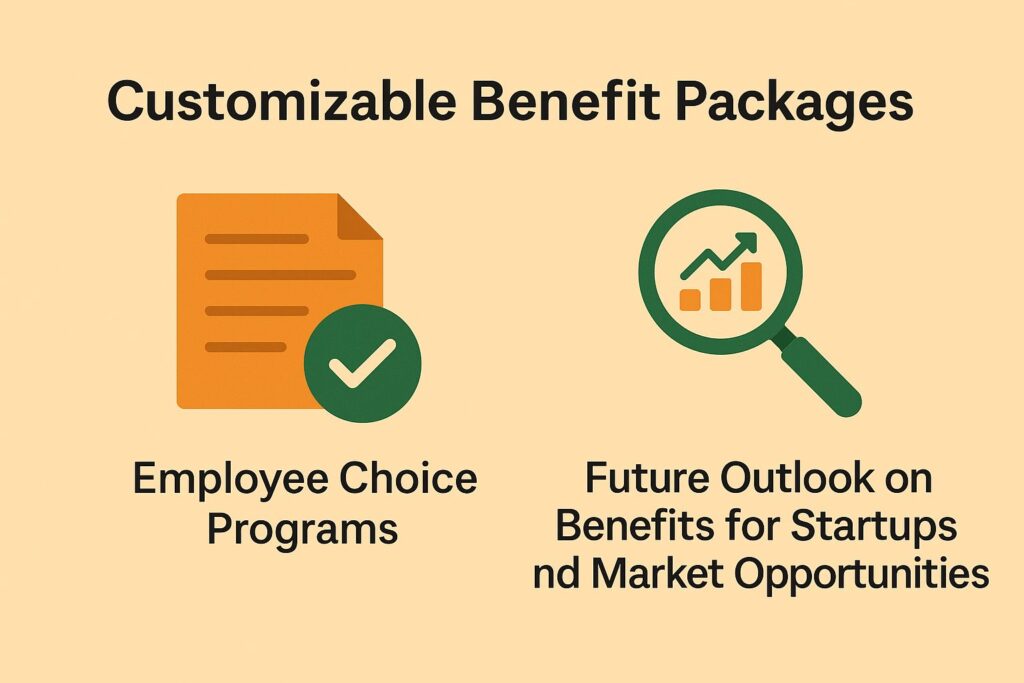
Employee Choice Programs
Employee choice programs let people pick benefits that match their personal needs, helping them feel happy at work and aligning with strategic planning.
Companies like Netflix and Google have successfully implemented these programs, allowing employees to choose between various health plans, retirement savings options, and even wellness benefits.
For instance, Netflix offers a flexible vacation policy where employees can take time off as needed, aligning work-life balance with personal needs.
Companies often see employee engagement scores rise by up to 20% because workers feel appreciated and happy when their preferences are put first. When employees are more satisfied, fewer leave their jobs, and overall work output improves.
What Lies Ahead for Startup Advantages and Market Chances
Employee benefits are changing, with more focus on fitting individual needs and promoting health and wellness benefits expected soon.
To stay ahead, startups should prioritize mental health initiatives by integrating services like teletherapy or mindfulness training directly into their benefits packages.
Providing flexible work setups, like a mix of office and remote work, suits what employees want and improves their mood.
Allowing employees to pick their own benefits boosts their satisfaction.
Using tools like Gusto or Zenefits can simplify setting up and managing these changing benefits with online HR systems.
About the Author
Ellen Westbrook is a Stanford University graduate with a bachelor’s degree in human resources and psychology. She’s the owner of a successful HR and payroll outsourcing firm in Colorado and a contributing writer for HR Costs. With 17 years of experience, Ellen helps businesses reduce risk, manage HR more efficiently, and grow with confidence.

